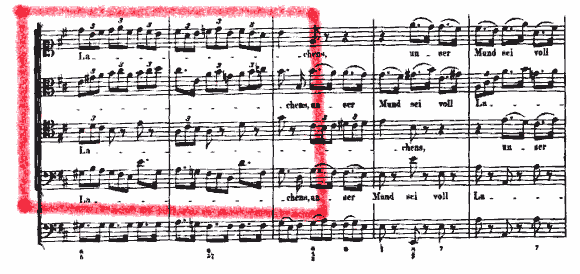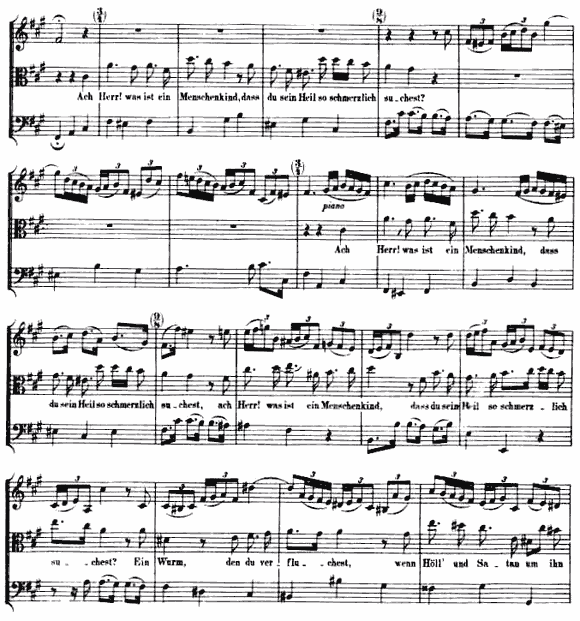For some time, it was believed that this cantata was written for the end of the War of the Polish Succession in 1734. Studies on the cantata in the 1950s pushed back the date of origin to 1725. Scholars today acknowledge Christmas Day 1725 as the date of the first performance of this work. The opening movement is an obvious example of Bach’s self-borrowing, as it clearly is an adaptation of the first movement of his own Orchestral Suite No. 4 in D major. (It is also remarkably similar to the opening movement of Orchestral Suite No. 3, also in D major.) Both use the same scoring of three trumpets, timpani, three oboes, strings, and continuo. At the point where the tempo changes, voices are added in the cantata. Because of the dates of the cantata and orchestral suites, the presence of trumpets here has caused some scholars to believe that the suite may have existed in a previous version which did not contain trumpets or drums – and possibly was written for strings alone.
The text for the opening movement comes from Psalm 126:2-3 – “Then our mouth was filled with laughter and our tongue with shouts of joy…The Lord has done great things for us.” The brilliant, majestic setting clearly prepares us for the ‘shouts of joy’. When the voices enter, there is a clear sense of laughter in Bach’s setting. We can see how easily Bach achieves this: each of the voices enters in imitation with the same text, but eventually all arrive simultaneously on a syllable with an “a” vowel. Bach writes numerous melismas on this “ah” sound, and with the lilting rhythm, the sound of laughter is genuinely achieved.

Bach treats this quicker portion of the movement almost as a concerto grosso for voices. Certain passages are marked “senza ripieni”, indicating that the full choir drops out, and a solo group instead carries the music forward. This is accompanied by a distinct change in the supporting orchestration, where the texture thins, and trumpets and drums are nowhere to be found. At almost 190 measures, this first movement is not only unusually large, it also serves as the focus of the entire cantata. After a strong cadence in D major at m. 169, the voices drop out and the opening, slower, majestic instrumental music returns as a coda to the whole movement. It is an unusually difficult and demanding movement for the voices, where the vocal writing is very instrumental in style.
The second movement is an aria for tenor. This provides a strong contrast in so many ways with the opening movement. Where the opening was brilliantly scored (in terms of color), this one is more subdued, using two flutes and continuo (bassoon and organ are indicated) to accompany the tenor voice. The movement shifts to the relative minor key of b minor. While the first movement was more joyful, the second is more contemplative. This is obvious not only in the sound of the music but in the text as well. There is a distinct shift from activity (laughter, shouting, praise) to more inward ideas (thoughts and senses). It is a demanding movement for the tenor soloist, in large part because so much of the writing lies in the higher part of the register. This higher register in the voice, coupled with the lighter, higher sounds of the flutes (instead of the oboes in the first movement), and the lighter continuo sound all contribute to a feeling of lightness, of movement upward, where the tenor asks we direct our thoughts (heavenward).
The third movement is a short accompanied recitative for bass solo, strings, and continuo. This leads directly to another aria, composed in the style of a trio sonata. There are two distinct melodic lines woven together, yet functioning independently in the solo alto and in the oboe d’amore. These are supported by the steady continuo line. Despite the F-sharp minor tonality, this is a warm movement. The words “aus Liebe” in the final line of the text link this aria to another famous aria by Bach, “Aus Liebe” from the Saint Matthew Passion. In that case, two oboes d’amore accompany a solo soprano, noticeably without the continuo part. But Bach seems very much to like the oboe d’amore with the solo female voice, perhaps because of the intimate, warm sound they produce in combination. We can almost sense that Mary, Jesus’s earthly mother, might be the singer here, attempting at once to calm her newborn son while also wondering aloud to God the Father why the child must suffer. The triplet figures added regularly to the oboe d’amore line add a lilt which assists in the calming effect of the movement.

This is an example of an aria based on da capo principles, though the return to the opening material occurs in the instrumental parts.
The concerns of the Virgin Mary are set aside in the next piece immediately, with the resumption of a major tonality (A major, the relative major of the preceding aria, and dominant to the opening movement as well as to the succeeding one). The text is the oft-used Christmas text sung by the multitude of heavenly hosts (Luke 2:14): “Ehre sei Gott in her Höhe und Friede auf erden und den Menschen ein Wohlgefallen” (Glory to God in the highest and peace on earth to mankind goodwill). This movement was derived from Bach’s earlier “Virga Jesse floruit”, sung on feasts of the Blessed Virgin Mary, in his Latin setting of the Magnificat (BWV 243). The key is transposed and different soloists are used, but the music is distinctly derived from that source (Robertson and Bomba). That text refers to the Savior springing from Jesse’s stem, so there is a logical textural connection between that text and anything used for Christmas, where we witness the realization of the prophesies.
The next movement is another aria, this time for bass. The orchestration is expanded here to include solo trumpet, two oboes, strings, oboe da caccia, and continuo. Like the first movement, this is another call for shouts of praise. In the middle section, the text refers specifically to “andachtsvollen Saiten” (worshipful string); Bach follows this textual cue by dropping the winds out of the texture. Since the aria is set in D major and with the trumpet taking the lead in the opening passage, knowing the solo bass voice is coming, modern listeners may find a natural link between this aria and Handel’s later work, “The Trumpet Shall Sound” from Messiah, written some sixteen years later.
The brightness of this movement holds despite a turn to a starker chorale setting to close the cantata. The “Alleluia” shouts in the final movement are tempered with the more solemn b minor key and reduction to a simple four-part setting. Ending on a B major chord (the Picardy third), however, brings a hopeful ending, and keeps the focus on the joy which God hath wrought, rather than the inevitable suffering which the Messiah will eventually face.


































